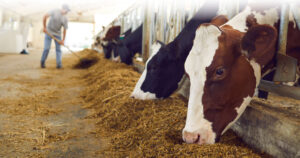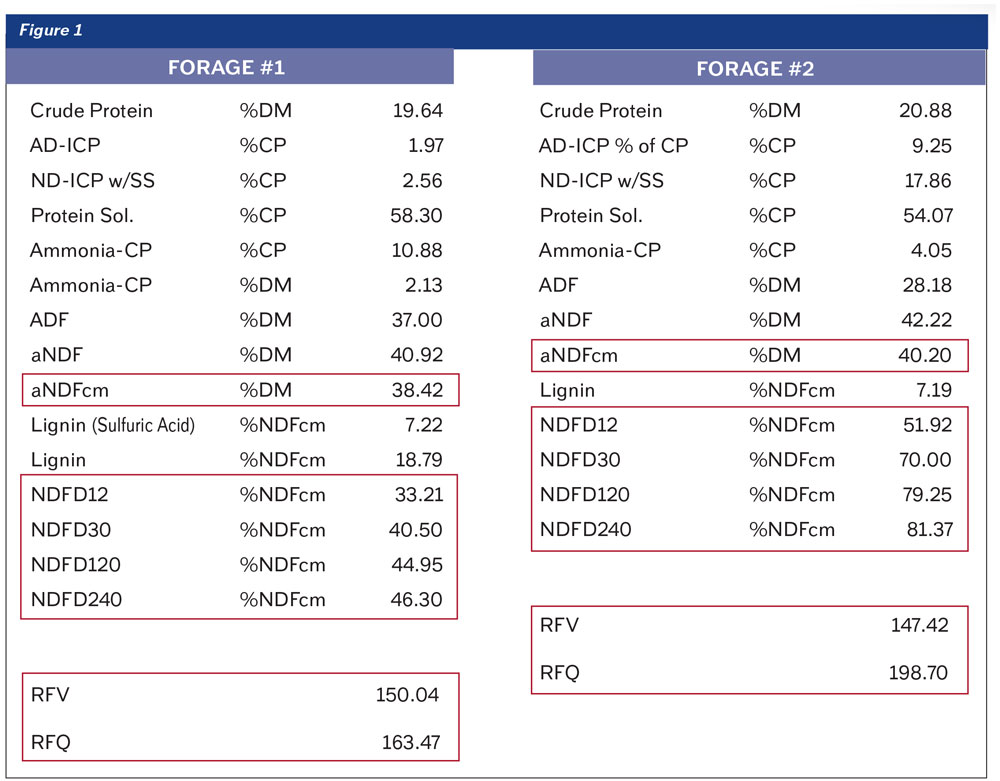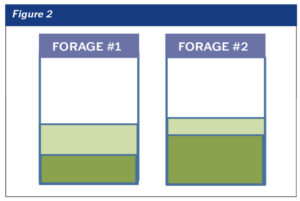RFV Does Not Love You Back
Click here to view as a pdf: RFV Does Not Love You Back
 By Erik Brettingen, B.S.
By Erik Brettingen, B.S.
Relative Feed Value (RFV) has been used as a method to quickly evaluate forages and make assumptions of animal performance when that forage is fed. Generally, the thought is that the higher the number the better. While there can be some truth to this at times, RFV misses out on arguably the most important piece to the puzzle when feeding forage to cows; neutral detergent fiber digestibility (NDFD). Crystal Creek® focuses on maximizing energy corrected milk with forage by utilizing farm grown feeds in the diet. To do this, we need to dig much deeper when evaluating forages and providing the best rations for rumen health and profitable production. Other tools like Relative Forage Quality (RFQ), and better yet, the NDF digestibility, really help pin down how to maximize forage in the ration and maintain productive cows.
RFV is determined using the acid detergent fiber (ADF) and NDF values of a feed and estimates the energy available to the animal based on the ADF content and then predicts the intake of the feedstuff based on the NDF value.
 The system was originally designed based off full bloom alfalfa having an RFV of 100. Lowering ADF and NDF content in the feed improves the forage drastically as measured by RFV. The issue with this is there is no consideration for the digestibility of that NDF and no correlation to how a cow really works. This can lead producers, and some nutritionists, to believe that higher NDF levels are bad and fiber levels in feeds should be reduced. This is seen more in alfalfa based forages and causes rations that are lower than ideal in overall NDF percentage (26-28%).
The system was originally designed based off full bloom alfalfa having an RFV of 100. Lowering ADF and NDF content in the feed improves the forage drastically as measured by RFV. The issue with this is there is no consideration for the digestibility of that NDF and no correlation to how a cow really works. This can lead producers, and some nutritionists, to believe that higher NDF levels are bad and fiber levels in feeds should be reduced. This is seen more in alfalfa based forages and causes rations that are lower than ideal in overall NDF percentage (26-28%).
RFQ came as an improvement to RFV, especially for forages that contain more grass. RFQ takes a more comprehensive approach and uses total digestible nutrients along with NDF digestibility in the equation. This helps better explain how the feed will perform in the cow, how much energy it provides, and essentially, how much digestible fiber is available for the rumen microbes.
To fully understand and estimate how cows will respond to a certain feedstuff, we first need to understand the cow and the rumen, and what makes it all work. Being ruminants, cows thrive on fiber, and more specifically digestible NDF. Digestible NDF can provide the majority of the energy in the diet as well as be the biggest driving factor of microbial protein production in the rumen. With more digestible NDF, the cow can eat more. This is what leads to more energy corrected milk. With digestible NDF being so crucial to cow health and performance, it makes complete sense to focus on maximizing it in the diet. In the industry, there is a lot of focus on expensive additives that improve milk production and components. These additives include amino acids and by-pass fats. While there is a time and a place for these additives and we do see responses with them, the initial conversation needs to be about improving NDF digestibility in the rumen because that’s where the profit is for the farmer. If forages can be grown and fed that have larger amounts of NDF, but the NDF is highly digestible, the cow’s supply of NDF to digest and utilize increases. This is like giving her a big gas tank with the best fuel for a cow to run on. This leads to the possibility of feeding higher forage diets that increase energy supply to the cows, improve rumen health, and increase component production and overall energy corrected milk. This is the formula for profitable dairy production:
- Buy less from the feed mill.
- Produce more energy corrected milk (Pounds of fat and protein).
- Improve cow health and keep cows in the herd longer.
To understand this better, the above chart shows a comparison between two forages and the impacts they have in a lactating ration.
Forage 1 has lower NDF and a higher RFV. When taking a look at NDF digestibility, only 40.6% of the NDF in this feed will digest in the rumen in 30 hours. Now compare this to Forage 2, which has a lower RFV and higher NDF value. When we dig deeper, we see that in 30 hours, 70% of the NDF will be digested by the cow! This feed, although lower RFV, has a significantly larger amount of digestible NDF for the cows to work with and make milk out of. The graphics in green give a visual representation of this. With the light green representing the total NDF in the crop and the dark green showing how much of that NDF is digestible.
When added into lactating rations, the difference in NDF leads to positive changes in milk production, factors contributing to cow health, and most importantly, profitability. The key diet differences are listed in the table above.
Feeding more digestible NDF leads to 1.94 lb. more energy corrected milk feeding 3.25 lb. less concentrate and reduces purchased feed cost. This increases income over purchased feed cost by $0.58 per cow per day. That is a profit improvement of $211.70 per cow per year or $21,170.00 for every 100 cows! This does not include possible economic benefits from improved cow health.
Realizing that fiber is not the enemy, and shifting the focus towards maximizing digestible NDF in lactating rations leads to positive changes in energy corrected milk, ration economics, and cow health. If you have questions or would like to learn more about how to feed more fiber to your cows, contact a Crystal Creek® nutritionist at 1-888-376-6777 today.
References available upon request.



